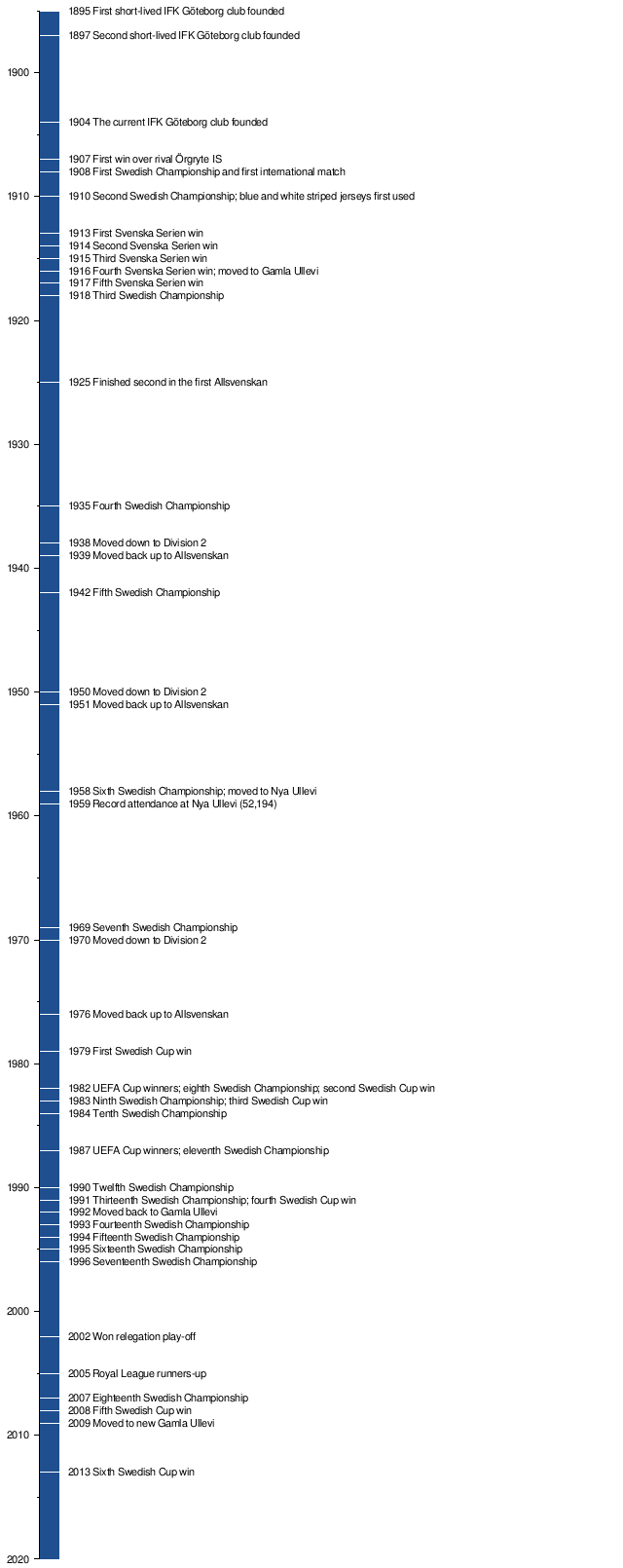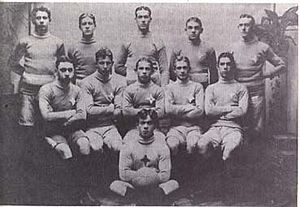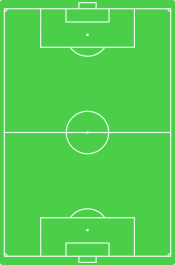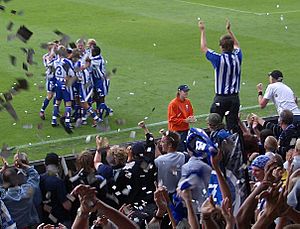History of IFK Göteborg facts for kids
Idrottsföreningen Kamraterna Göteborg, known as IFK Göteborg, is a professional football club from Gothenburg, Sweden. It's one of the most famous and successful football teams in Sweden. The club is often called "Blåvitt" (Blue-White) because of its team colors.
Contents
Early Years: 1895–1904
|
|
| IFK Göteborg's first kit, used in 1904 and 1905. |
The first IFK club in Gothenburg started in 1895. It didn't last long. Another attempt was made in 1897 by two brothers, Friman. This club was active until 1899. Their main sport was athletics. Even an Olympic gold medalist, Eric Flemming, was part of the club for a short time.
There was no IFK club in Gothenburg between 1900 and 1904. The IFK Göteborg we know today was founded on 2 October 1904. A few friends, including Arthur Andersson, wanted to start an IFK club. They wondered why Gothenburg, a big city, didn't have one. Two days later, on 4 October, IFK Göteborg became the 39th IFK club. They decided their colors would be blue and white, like most IFK clubs. Their first uniform was supposed to be blue and white striped jerseys with blue shorts. But they didn't have enough money. So, they used blue jerseys with a single white stripe instead.
Building the Team: 1904–1919
The first game IFK Göteborg ever played was a 4–1 win against IK Viking. This new club was important for football in Gothenburg. Before IFK, Örgryte IS (ÖIS) was the strongest team. IFK Göteborg brought new competition. At first, ÖIS still won most games.
On 13 October 1907, IFK Göteborg finally beat ÖIS. This was a big deal, as ÖIS had been winning for four years. IFK also won the local league in Gothenburg. In 1908, IFK won the Svenska Mästerskapet, becoming Swedish Champions for the first time. Three IFK players were chosen to play for the Swedish national team in their very first game. IFK player Erik Börjesson scored Sweden's first goal. Later that year, IFK played against international teams from Denmark for the first time.
In 1910, IFK finished third in the first Svenska Serien league. But they were still named Swedish Champions because they won Svenska Mästerskapet. This year, the team finally wore their blue and white striped jerseys. In 1912, a newspaper in Stockholm called IFK Göteborg "the best Swedish football club ever." The next year, IFK Göteborg's players even represented the Swedish national team in a game against Norway. This was the only time the national team was made up of players from just one club.
In 1914, a big fight happened during a game between IFK and ÖIS. In 1916, IFK moved to its new home stadium, Gamla Ullevi. IFK Göteborg won Svenska Serien five times in a row by 1917. But World War I and the Spanish flu caused the league to stop. A new competition, Fyrkantserien, was started in 1918, and IFK won that too.
The Golden Age Begins: 1920–1939
|
|
| Blue-white stripes, common in the 1920s and 1930s. |
The 1920s started with IFK beating local rivals GAIS and ÖIS. In 1921, IFK got its first official coach, Alexander Brody from Hungary. The Svenska Serien league was played again but then stopped in 1924. In 1923, IFK, ÖIS, and GAIS chose not to play in the Swedish Championship tournament due to a disagreement with the Swedish Football Association.
The first official Swedish national league, Allsvenskan, began in 1924. That same year, the famous Filip "Svarte-Filip" Johansson started playing for IFK Göteborg. IFK's first Allsvenskan game was a 1–1 draw against Malmö FF. The club finished second, and "Svarte-Filip" was the top scorer with 39 goals. For the next five seasons, IFK always finished in the top four. Football in Sweden was still mostly controlled by the three big Gothenburg clubs: IFK, ÖIS, and GAIS.
The 1930s also saw many second and third-place finishes. In 1933, "Svarte-Filip" retired. He had scored 177 goals in 181 Allsvenskan games and 329 goals for IFK in total. IFK finally won its first Allsvenskan title in 1935. IFK and its players chose not to participate in the 1936 Summer Olympics in Berlin. In the late 1930s, Gothenburg teams were not as dominant. Both IFK Göteborg and GAIS were moved down to a lower league in 1938. But IFK quickly moved back up to Allsvenskan the next season. Even with World War II starting, IFK finished second in the league that year.
Ups and Downs: 1940–1969
During the 1940s, many players had to do military service. Gunnar Gren, a future star, joined IFK as they won the league in 1942. The rest of the 1940s were tough for the club. IFK was moved down from Allsvenskan for the second time. Gunnar Gren was a bright spot. He was the top scorer in 1947 and won an Olympic gold medal with Sweden in 1948. He was also named the best player in Sweden.
IFK moved back up to Allsvenskan after just one season. They almost moved down again in 1955. The talented Bertil "Bebben" Johansson scored 27 goals when IFK won the league in 1958. This was the first time IFK played in a European cup, the European Champion Clubs' Cup. They were knocked out in the second round. In 1959, a record 52,194 fans watched IFK play ÖIS at Nya Ullevi. This is still the highest attendance record for an Allsvenskan game.
IFK Göteborg got the nickname "Änglarna" (the Angels). A newspaper seller gave them the name after seeing a beautiful freekick by "Bebben." The club's training ground, "Kamratgården," opened in 1961. The 1960s were not a great time for the club. IFK usually finished in the middle of the league. Bengt "Fölet" Berndtsson retired in 1967. He had played a record 598 matches for IFK. Surprisingly, the team won Allsvenskan again in 1969.
European Glory: 1970–1989
|
Wernerson
Svensson
Karlsson
Fredriksson
Holmgren
Strömberg
Carlsson
Holmgren
Nilsson
Corneliusson
|
| The starting team for the 1982 UEFA Cup finals. |
The year 1970 was very difficult for IFK. After winning the league the year before, the team was moved down to a lower league. Some angry fans caused problems on the field during the last game. IFK was also knocked out of the European Cup early. For three seasons, IFK stayed in the second league.
In 1975, IFK bought two important players, Torbjörn Nilsson and Ove Kindvall. Torbjörn Nilsson helped lead the way, and IFK was promoted back to Allsvenskan in 1976. A poll showed that 60% of people in Gothenburg supported IFK. A new record was set for the second league when 50,690 people watched IFK play GAIS.
In 1978, IFK hired coach Sven-Göran Eriksson. He introduced a new playing style called "pressure and support." This system would bring IFK great success. The 1970s ended with IFK finishing second in Allsvenskan and winning their first Svenska Cupen (Swedish Cup).
In 1982, IFK faced financial difficulties. They even had to borrow money from their fan club. But despite this, IFK had an amazing year. They won everything: Allsvenskan, Svenska Cupen, and the UEFA Cup. They beat strong teams like Valencia and Hamburger SV in the finals.
After this European success, many players left to play abroad. But IFK still had a strong team. They won the league in 1983 and 1984, and the cup in 1983. IFK also reached the quarter-finals of the European Cup two years in a row. In 1986, they made it to the semi-finals but lost to FC Barcelona on penalties. In 1987, a new group of talented players won both the UEFA Cup and Allsvenskan again. The late 1980s saw the team getting older. In 1989, Roger Gustafsson, the junior coach, took over the team.
Continued Success: 1990–1999
Roger Gustafsson's first game as coach in 1990 was a tough 0–6 loss. He used many young players and was criticized. But the next game was a 5–0 win, showing his approach was working. IFK won Allsvenskan again that year. It was also decided to move back to the old Gamla Ullevi stadium. IFK won the league and the cup in 1991, and Gustafsson became a hero. In 1992, IFK finished fifth in Allsvenskan. But they did well in the UEFA Champions League, beating PSV Eindhoven twice.
IFK won Allsvenskan in 1993, their 14th title, a Swedish record. They qualified for the Champions League again. IFK won their group, which included FC Barcelona and Manchester United. No one expected them to do so well. They beat Galatasaray twice, and Manchester United and Barcelona once. They then played Bayern Munich in the quarter-finals.
The 1995 season started with the quarter-finals against Bayern Munich. Both games were draws, but IFK was eliminated because Bayern scored more goals away from home. IFK won the league for the third time in a row. But they were knocked out of the Champions League early. Roger Gustafsson's amazing coaching career ended. Some IFK fans caused problems during a Champions League game. Because of this, IFK had to play their next home game far away from Gothenburg.
Even with a new coach, Mats Jingblad, IFK kept playing well. They won Allsvenskan in 1996 for the fourth time in a row. This qualified them for the Champions League again. IFK beat A.C. Milan 2–1 at home but lost their other five games in the group. The last years of the 1990s were not as good. They finished second in 1997 and eighth in 1998. Jingblad was fired during the 1998 season. The club changed coaches in the middle of the season two years in a row, which was very unusual for them. The decade ended with a sixth-place finish.
A New Millennium: 2000–2009
The 2000s started well for IFK. They bought new players who helped the team. IFK was at the top of Allsvenskan in the summer. But when a key player, Stefan Landberg, got injured, the club dropped to fourth place. In 2001, IFK was a favorite to win the league. They started strong, but injuries to important players caused them to lose key games. They finished fourth again.
The 2002 season was very difficult. Key players left or got injured. The club also faced financial problems and had to sell a striker. IFK dropped to the bottom of the league. They barely avoided moving down to a lower division after two playoff games. In the UEFA Cup, they lost to a Moldavian club, which was a big disappointment. The coach was fired, and Roger Gustafsson temporarily returned. The 2003 season was a bit better. IFK played inconsistently, winning against top teams but losing or drawing against others. They finished seventh.
For the 2004 season, IFK looked strong with new players. They were in the fight for the league title but finished third. They reached the final of the Swedish Cup but lost. In 2005, IFK reached the final of the first Royal League (a Scandinavian championship). But the club faced legal issues regarding player transfers. Despite this, they had a good season and finished second. Håkan Mild retired as a player and became the new director. In 2006, after selling two defense players, the team struggled and finished eighth. The coach was fired.
Few expected IFK to win the title in 2007 because the team had many young players. But they had a great mix of young talent and experienced players. They won the title for the first time in 11 years. They also reached the Swedish Cup final but lost. The young striker Marcus Berg scored 14 goals and was sold.
In 2008, IFK won the Swedish Supercup. In Allsvenskan, they had problems with scoring goals early in the season. But when young forward Robin Söder started playing, the team improved. IFK played well in the UEFA Champions League qualifiers but lost. This was a disappointment. However, the season ended better as they won the Swedish Cup after beating Kalmar FF on penalties. IFK finished third in Allsvenskan.
In 2009, IFK Göteborg played at the newly renovated Gamla Ullevi stadium. They started the season with a big 6–0 win. The club played very well in the spring and was at the top of the league. But during the summer, they had many injuries and lost points. They were also defeated in the UEFA Europa League qualifiers. IFK bought new players and won many games in the autumn. In the last game, IFK was just one point behind the league leader, AIK. But they lost to AIK and finished second. IFK also reached the Swedish Cup final but lost to AIK again.
Recent Years: 2010–Present
Before the 2010 season, IFK bought striker Pär Ericsson. They were favorites to win the league, but the season started badly with many injuries. IFK had very poor results in the spring and was close to the relegation zone. After the summer, they played better but finished seventh. Some players were sold. In the UEFA Europa League qualifiers, IFK played well but were eliminated.
Despite the bad results in 2010, the team kept coach Jonas Olsson for the 2011 season. IFK didn't make many big changes to the team. The season started terribly with four losses in the first four games. The team started winning later in the spring and summer. But after losing close games to top teams, it was clear IFK wouldn't finish in the top four. They finished seventh. IFK reached the semi-final of the Swedish Cup but were eliminated. During the summer, some players were transferred to and from the club.
After the disappointing 2011 season, coach Jonas Olsson left. IFK chose Mikael Stahre as the new coach, which was a surprise because he had coached their rivals, AIK. The club bought several well-known players. IFK was a favorite to win Allsvenskan in 2012 and was even nicknamed "Real Blåvitt" (Real Bluewhite) by the media.
However, Allsvenskan started very badly with losses and draws. The defense struggled, and many potential wins turned into draws. After a big 0–5 loss, the team was close to the relegation zone. An old defender, Mattias Bjärsmyr, returned, and the team started winning again. With only one loss in ten games, the club secured their place in the league for 2013. IFK finished seventh again. In the summer, midfielder Tobias Sana was sold.
Timeline of IFK Göteborg's History

See also
- Football in Sweden




